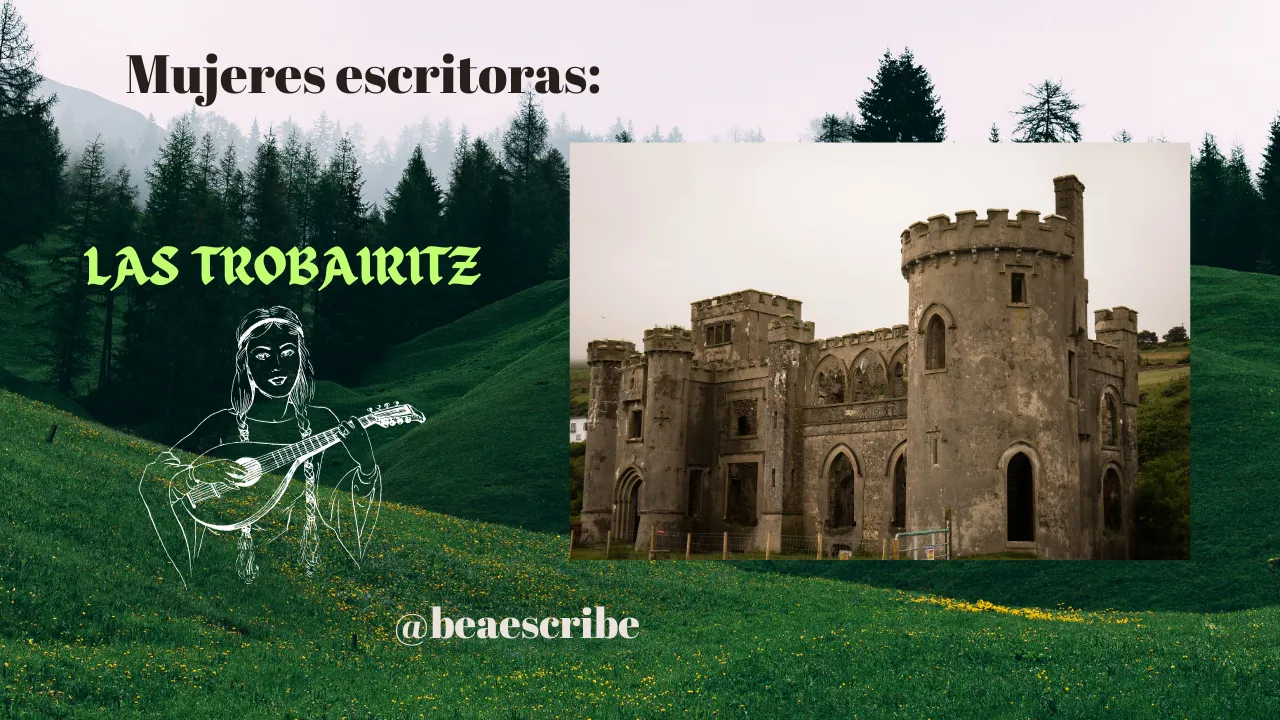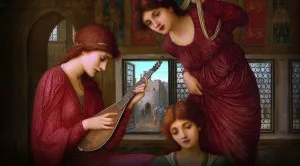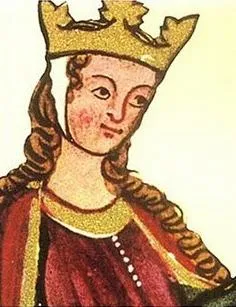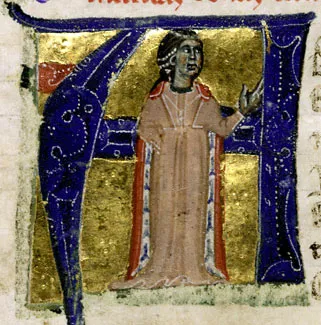
Las Trobairitz

Selección de algunas canciones de trobairitz medievales
Leonor de Aquitania

QUÉ DOLOROSO ES AMAR…
¡Qué doloroso es amar...
y no poderlo decir!
Si es doloroso saber,
que va marchando la vida
como una mujer querida,
que jamás ha de volver.
Si es doloroso ignorar,
donde vamos a morir;
¡más doloroso es amar...
y no poderlo decir!
Triste es ver que la mirada,
hacia el sol levanta el ciego;
y el sol la envuelve en su fuego
y el ciego no siente nada.
Ver su mirada tranquila,
a la luz indiferente
y saber que eternamente,
la noche va en su pupila
bajo el dosel de su frente.
Pero si es triste mirar
y la luz no percibir;
¡más doloroso es amar...
y no poderlo decir!
Conocer que caminamos,
bajo la fuerza del sino;
recorrer nuestro camino
y no saber dónde vamos.
Ser un triste peregrino,
de la vida en los senderos,
no podernos detener,
por ir siempre prisioneros,
del amor o del deber.
Mas si es triste caminar
y no poder descansar
mas que al tiempo de morir;
¡más doloroso es amar...
y no poderlo decir!
Vivir como yo soñando,
con cosas que nunca vi;
y seguir, seguir andando,
sin saber por qué motivo
ni hasta cuándo.
Tener fantasía y vuelo,
que pongan al cielo escalas
y ver, que nos faltan alas,
que nos remonten al cielo.
Más si es triste no gozar,
lo que podemos soñar;
no hay más amargo dolor,
que ver el alma morir,
prisionera de un amor
y no poderlo decir.
Leonor de Aquitania -
(Traductor: Joaquín Dicenta)
Beatriz, condesa de Día
He estado muy angustiada
He estado muy angustiada
Por un caballero que he tenido
Y quiero que por siempre sea sabido
Cómo le he amado sin medida;
Ahora comprendo que yo me he engañado,
Porque no le he dado mi amor,
Por eso he vivido en el error
Tanto en el lecho como vestida.
Cómo querría una tarde tener
A mi caballero, desnudo, entre los brazos,
Y que él se considerase feliz
Con que sólo le hiciese de almohada;
Lo que me deja más encantada
Que Floris de Blancaflor:
Yo le dono mi corazón y mi amor,
Mi razón, mis ojos y mi vida.
Bello amigo, amable y bueno,
¿Cuándo os tendré en mi poder?
¡Podría yacer a vuestro lado un atardecer
y podría daros un beso apasionado!
Sabed que tendría gran deseo
De teneros en lugar del marido,
Con la condición de que me concedierais
Hacer todo lo que yo quisiera.
De alegría y juventud me sacio
De alegría y juventud me sacio
Y alegría y juventud me sacian
Porque mi amigo es el más alegre,
Por lo que yo soy graciosa y alegre;
Y ya con él soy sincera,
Bien pretendo que conmigo sea sincero,
Que nunca de amarlo me abstengo,
Ni corazón para hacerlo.
Mucho me place, desde que sé que es el
Más valiente
Aquel que más deseo que me posea,
Y ruego a Dios que le dé felicidad
A aquel que primero lo trajo hacia mí;
Y no crea a ninguno de los que
Le censuran
Salvo a quien le advierte
Que se recibe a medida
De lo que se ha hecho.
Una dama que mire el buen valor,
Bien debe poner su intención
En un caballero valiente y cortés
Desde que conoce su valor;
Y que ose amarle abiertamente:
Porque de una dama que ama sin
esconderse
los valerosos y los valientes
no dirán más que bien.
Yo he escogido un hombre valioso y cortés
Cuyo valor mejora y aumenta,
Generoso, recto y prudente, que tiene juicio y sensatez.
Le ruego que me crea,
Y que nadie pueda hacerle creer
Que yo he cometido jamás falta hacia él;
Y no encuentro en él ningún defecto.
Amigo, vuestro valor
Los valientes y los valerosos conocen,
Por eso yo os suplico darme,
Si os agrada, vuestra protección.
Florencia Pinar
Otra canción de la misma señora a unas perdices que le embiaron bivas
D’ estas aves su nación
es cantar con alegría,
y de vellas en prisión
siento yo grave passión,
sin sentir nadie la mía.
Ellas lloran que se vieron
sin temor a ser cativas,
y a quien eran más esquivas
essos mismos las prendieron.
Sus nombres mi vida son,
que va perdiendo alegría,
y de vellas en prisión
siento yo grave passión,
sin sentir nadie la mía.
En esta canción la poeta se identifica con unas perdices que han sido cautivadas y ahora se encuentran prisioneras en una jaula y la infelicidad que esto les causa. Nos habla así de manera simbólica de la poca libertad que tenían las mujeres en aquel momento, especialmente si hacían vida en la corte.
María Pérez Balteira
Bibliografía consultada
Poesía medieval. (Edición de Víctor de Lama). Barcelona: De Bolsillo, 2002.
https://es.wikipedia.org/wiki/Trobairitz
https://musicaantigua.com/las-trobairitz-talentosas-mujeres-trovadoras-silenciadas-por-la-historia/
https://es.wikipedia.org/wiki/Leonor_de_Aquitania
https://es.wikipedia.org/wiki/Beatriz_de_D%C3%ADa
https://es.wikipedia.org/wiki/Florencia_Pinar
https://es.wikipedia.org/wiki/Mar%C3%ADa_la_Balteira
@beaescribe/mujeres-escritoras-quien-las-borro
@beaescribe/mujeres-escritoras-safo-y-otras

Trobairitz

A selection of some medieval trobairitz songs
Eleanor of Aquitaine
Among the trobairitz, Queen Eleanor of Aquitaine (Poitiers, 1122-Fontevraud-l'Abbaye, 1204), whose legend has survived to the present day and continues to inspire novels, films, television series and graphic novels. Daughter of William X, queen consort of France (1137-1152) when she married Louis VII and then queen consort of England (1154-1189), when she married Henry II of England, after her marriage to Louis VII was annulled. She was patron of numerous troubadours and trobairitz, and trobairitz herself. Some of the songs she composed are still performed today. I share with you a poem by Eleanor of Aquitaine and a recording of one of her compositions.

HOW PAINFUL IT IS TO LOVE...
How painful it is to love...
and not to be able to say it!
If it's painful to know
that life is going by
like a beloved woman
who will never come back.
If it is painful to ignore
where we are going to die;
it is more painful to love...
and not being able to say it!
It is sad to see the gaze
towards the sun raises the blind man's eyes;
and the sun envelops it in its fire
and the blind man feels nothing.
To see his calm gaze,
in the indifferent light
and know that eternally
the night goes in her pupil
under the canopy of his forehead.
But if it is sad to look
and the light not to perceive;
it is more painful to love...
and not to be able to say it!
To know that we walk
under the force of fate;
to walk our path
and not knowing where we are going.
To be a sad pilgrim,
of life on the paths,
not being able to stop,
because we are always prisoners,
of love or duty.
But if it is sad to walk
and not be able to rest
but at the time of death;
it is more painful to love...
and not to be able to say it!
To live like me dreaming,
with things I never saw;
and to go on, to go on walking,
without knowing for what reason
nor until when.
To have fantasy and flight,
to put scales to the sky
and see, that we lack wings,
to soar to the sky.
More if it is sad not to enjoy,
what we can dream;
there is no more bitter pain,
than to see the soul die,
prisoner of a love
and not being able to say it.
Eleanor of Aquitaine -
(Translator: Joaquín Dicenta)
Beatrice, Countess of Día
I have been very distressed
I've been very distressed
For a gentleman I've had
And I want it to be known forever
How I have loved him beyond measure;
Now I understand that I have deceived myself,
Because I have not given him my love,
That's why I have lived in error
Both in bed and clothed.
How I would like one evening to have
My gentleman, naked, in my arms,
And for him to consider himself happy
With me only to be his pillow;
Which leaves me more enchanted
Than Floris of Blancaflor:
I donate to him my heart and my love,
My reason, my eyes and my life.
Beautiful friend, kind and good,
When shall I have you in my power?
I could lie by your side one sunset
And I could give you a passionate kiss!
Know that I would have great desire
To have you in your husband's place,
On condition that you would grant me
To do all that I would wish.
With joy and youth I am satiated
With joy and youth I am satiated
And joy and youth satiate me
For my friend is the most joyful,
So that I'm graceful and cheerful;
And already with him I am sincere,
Well do I pretend that with me he is sincere,
That I never refrain from loving him,
Nor heart to do so.
It pleases me much, since I know him to be the
Bravest
He whom I most desire to possess me,
And I pray God to give happiness
To him who first brought him to me;
And believe none of those who
censure him
Except those who warn him
That it is received in measure
Of what has been done.
A lady who looks on good courage,
Well should she set her intention
In a brave and courteous gentleman
Since she knows his worth;
And who dares to love him openly:
For from a lady who loves without
hide herself
The brave and the valiant
Will say nothing but good.
I have chosen a worthy and courteous man
Whose worth improves and increases,
Generous, upright, and prudent, Who has judgment and sense.
I pray him to believe me,
And that no one may make him believe
That I have ever committed any fault towards him;
And I find no fault in him.
Friend, your courage
The brave and the valiant know,
Therefore I beseech you to give me,
If it pleases you, your protection.
Florencia Pinar
Another song by the same lady to some partridges that were sent to her by bivas
D' these birds their nation
is to sing with joy,
and of them in prison
I feel grave passion,
without anyone feeling mine.
They cry that they saw themselves
without fear of being captive,
and to whom they were more elusive
those same ones have set them on fire.
Their names are my life,
that is losing joy,
and from them in prison
I feel a grave passion,
without anyone feeling mine.
María Pérez Balterira
Bibliography consulted
Poesía medieval. (Edición de Víctor de Lama). Barcelona: De Bolsillo, 2002.
https://es.wikipedia.org/wiki/Trobairitz
https://musicaantigua.com/las-trobairitz-talentosas-mujeres-trovadoras-silenciadas-por-la-historia/
https://es.wikipedia.org/wiki/Leonor_de_Aquitania
https://es.wikipedia.org/wiki/Beatriz_de_D%C3%ADa
https://es.wikipedia.org/wiki/Florencia_Pinar
https://es.wikipedia.org/wiki/Mar%C3%ADa_la_Balteira
I share with you the previous posts in this "Women Writers" series:
@beaescribe/mujeres-escritoras-quien-las-borro
@beaescribe/mujeres-escritoras-safo-y-otras
translation to english by deepl.com




